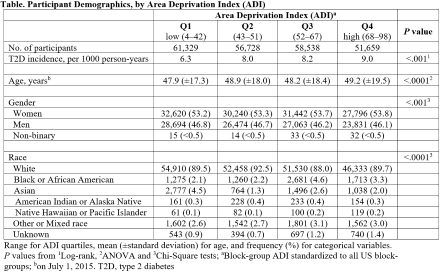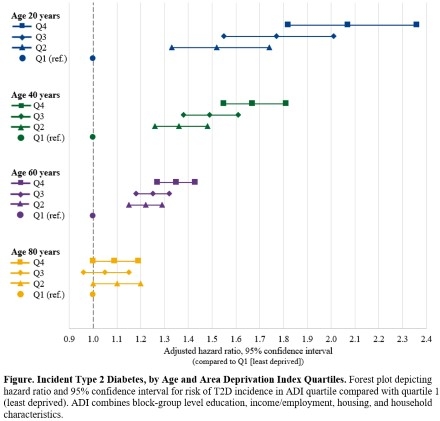Final ID: MDP443
Neighborhood-level Determinants and Disparities in Incident Type 2 Diabetes in a Population-Based Cohort, 2015–2020
Abstract Body (Do not enter title and authors here):
Introduction
Living in an area with high Area Deprivation Index (ADI) is linked to worse cardiovascular disease (CVD) outcomes. However, the association of ADI with type 2 diabetes (T2D), a major CVD risk factor, is incompletely described. This knowledge may guide primary CVD prevention.
Method
Rochester Epidemiology Project is a medical record linkage system of persons in southeast Minnesota and southwest Wisconsin. We identified 253,890 persons (aged 4–98 yrs on July 1, 2015) in 9 counties with >90% population coverage. ADI scores, from 2015 home addresses, were grouped into quartiles of low (Q1) to high (Q4) deprivation. We excluded persons with type 1 diabetes (T1D) or history of T2D and identified new T2D cases (2015-2020) using ICD codes, HbA1c and medications. We examined the association between ADI quartile and risk of incident T2D using Cox regression with persons right censored at death, T2D, T1D or last visit. Models were adjusted for age and gender, and reported adjusted hazard ratios (aHR [95% confidence interval]).
Results
Age, gender, and race statistically differed across ADI quartiles (Table). Age × ADI interaction was significant (P<.001). T2D incidence ranged from 6.3 (Q1) to 9.0 (Q4) per 1000 person-years (P<.001). Women vs. men/non-binary persons (combined due to limited non-binary persons) had 30% lower risk of incident T2D (aHR 0.70 [0.67–0.72]). Risk of incident T2D was higher in persons from higher ADI areas. At median age of 48.6 yrs, the risk was 30% higher in Q2 (aHR 1.3 [1.22–1.38]), 38% higher in Q3 (aHR 1.38 [1.30–1.47]) and 53% higher in Q4 (aHR 1.53 [1.43–1.62]) vs. Q1. Higher ADI was associated with higher incident T2D in younger persons, with risk attenuation with increasing age (Figure).
Conclusion
In this population cohort, persons, particularly of younger age, living in more deprived areas had a higher risk of incident T2D. ADI may help identify areas for targeted T2D screening, with implications for CVD screening and prevention.
Introduction
Living in an area with high Area Deprivation Index (ADI) is linked to worse cardiovascular disease (CVD) outcomes. However, the association of ADI with type 2 diabetes (T2D), a major CVD risk factor, is incompletely described. This knowledge may guide primary CVD prevention.
Method
Rochester Epidemiology Project is a medical record linkage system of persons in southeast Minnesota and southwest Wisconsin. We identified 253,890 persons (aged 4–98 yrs on July 1, 2015) in 9 counties with >90% population coverage. ADI scores, from 2015 home addresses, were grouped into quartiles of low (Q1) to high (Q4) deprivation. We excluded persons with type 1 diabetes (T1D) or history of T2D and identified new T2D cases (2015-2020) using ICD codes, HbA1c and medications. We examined the association between ADI quartile and risk of incident T2D using Cox regression with persons right censored at death, T2D, T1D or last visit. Models were adjusted for age and gender, and reported adjusted hazard ratios (aHR [95% confidence interval]).
Results
Age, gender, and race statistically differed across ADI quartiles (Table). Age × ADI interaction was significant (P<.001). T2D incidence ranged from 6.3 (Q1) to 9.0 (Q4) per 1000 person-years (P<.001). Women vs. men/non-binary persons (combined due to limited non-binary persons) had 30% lower risk of incident T2D (aHR 0.70 [0.67–0.72]). Risk of incident T2D was higher in persons from higher ADI areas. At median age of 48.6 yrs, the risk was 30% higher in Q2 (aHR 1.3 [1.22–1.38]), 38% higher in Q3 (aHR 1.38 [1.30–1.47]) and 53% higher in Q4 (aHR 1.53 [1.43–1.62]) vs. Q1. Higher ADI was associated with higher incident T2D in younger persons, with risk attenuation with increasing age (Figure).
Conclusion
In this population cohort, persons, particularly of younger age, living in more deprived areas had a higher risk of incident T2D. ADI may help identify areas for targeted T2D screening, with implications for CVD screening and prevention.
More abstracts on this topic:
Antihypertensive Medication Prescription Patterns at Baseline in the LINKED-HEARTS Program: A Comparative Analysis with American Heart Association Guidelines
Adomako Nana Ofori, Chen Yuling, Demarco Samantha, Chepkorir Joyline, Owusu Nti Kezia, Slone Sarah, Commodore-mensah Yvonne, Himmelfarb Cheryl
Artificial Intelligence Driven Subphenotyping of In-Hospital Cardiac Arrest Patients Identifies Subgroups with Different Outcomes and Risk Factors: A Nation-Wide AnalysisJiang Joy, Zebrowski Alexis, Bhatt Deepak, Nadkarni Girish, Abbott Ethan, Oh Wonsuk, Buckler David, Kittrell Hannah, Jayaraman Pushkala, Chan Lili, Vaid Akhil, Gulamali Faris, Redlener Michael


